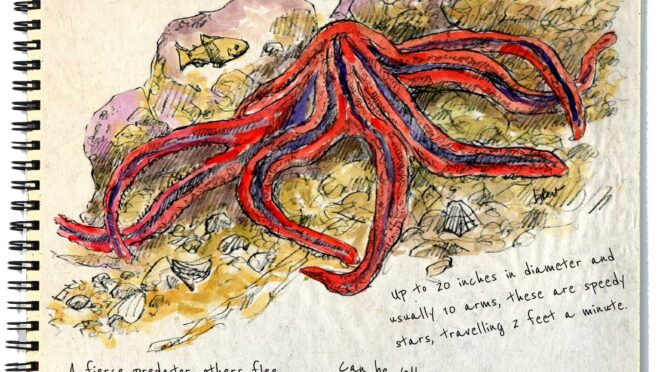Starfish are not fish, of course, but animals. There are many here, from the tiny blood star that can fit in the palm of your hand, to some that would easily fill a bailing bucket. This one, the striped sun star, might look attractive, but it is anything but – it’s actually a fearsome predator. Think big mountain lion, fast and dangerous. When other sea stars, urchins or smaller ocean animals sense one of these coming, they move out of the way as fast as their arms, or spines or fins can carry them. Sometimes it’s not fast enough. These many-armed warriors can move over 2 feet per minute, amazingly fast for a creature with hundreds of suction cup feet. They pump water into the suction cups for movement, but they also use them to grab prey and transfer it to the waiting mouth. Prey too big to fit? Well, there’s this other adaptation. They can extrude their stomach out through the mouth to engulf the still-kicking hapless victim. Stomach acids then take care of things in short order and the stomach returns into the mouth. This allows for the consumption of larger prey that wouldn’t initially fit into their flat bodies. Could I make this up? These stars are long-lived, some last 30 years, meaning they’re successful at what they do. Armoring on the outside and a hidden mouth beneath the center part make them safe, and they can regrow a severed arm. It may take years to complete, but injured stars can become whole again. Like us, they’re not immune to viruses or diseases and, like most other stars, they have been ravaged by Wasting Disease in the past few years, another obvious result of warming oceans and Climate Change. And, like COVID, they don’t have a way to become immune to it except to let nature take its course.
Larry Eifert paints and sails the Pacific Northwest from Port Townsend. His large-scale murals can be seen in many national parks across America, and at larryeifert.com.

